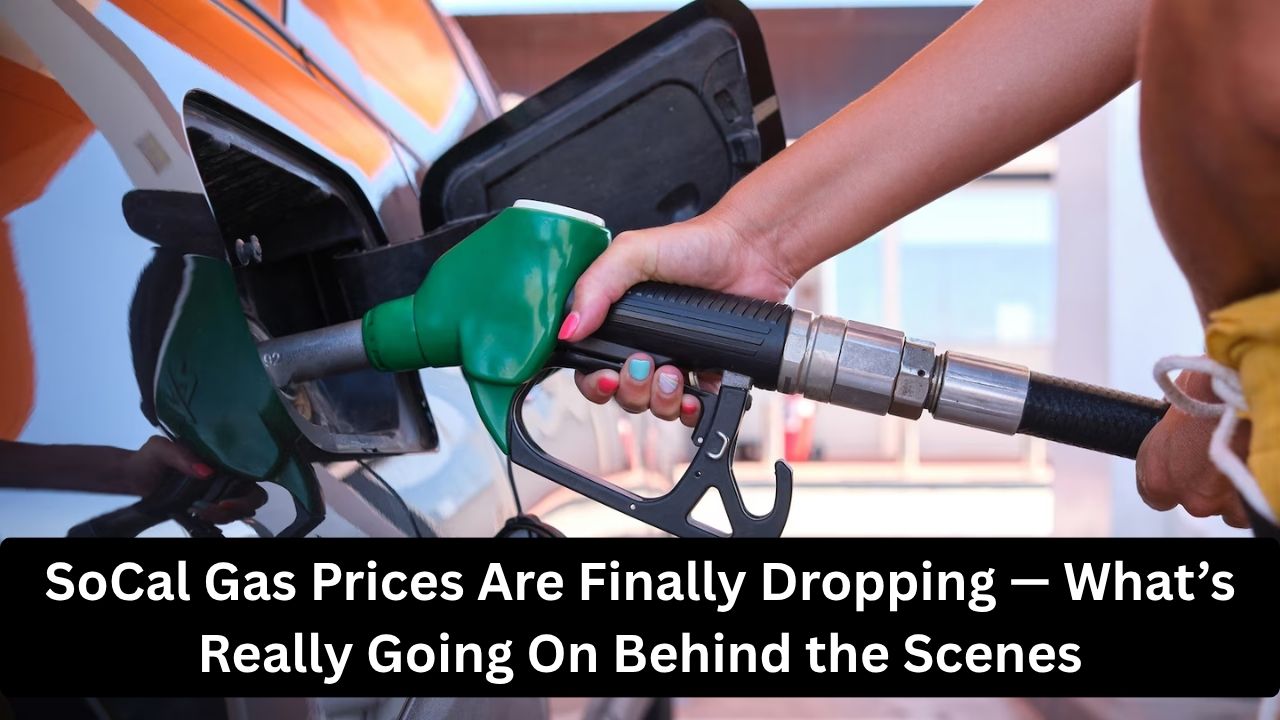Southern California drivers are enjoying a long-awaited surprise these days: petrol costs are really decreasing. People in Los Angeles, Orange County, San Diego, and the Inland Empire have become accustomed to paying exorbitant rates at petrol stations for months. Many people believed that the cost of petrol would continue to rise indefinitely.
But now, something is finally changing. Gas station signage that used to make drivers grimace is gradually disappearing. The drop isn’t dramatic yet, but it’s consistent enough that many people notice the change when they fill up their tanks. And in a location where the cost of living is already high, even a little reduction in gas costs feels significant.
This story explains in simple, common language why Southern California gas prices are dropping, what’s causing the shift, how various counties are affected, and what experts predict will happen next. The idea is to assist you comprehend the problem without utilizing complex economic words or confusing explanations.
Why This Drop Matters Right Now
Fuel bills are a significant portion of many Southern California households’ monthly budgets. People who travel long miles for employment, parents who commute to school and events, and delivery or rideshare drivers are particularly affected. When gas costs climb, every errand, job shift, and family excursion becomes slightly more expensive.
That’s why the latest price decrease is such good news. At a time when inflation has driven up the cost of practically everything—groceries, rent, and utilities—even a modest respite at the pump may make a significant difference. It’s more than simply saving a few bucks; it’s about relieving the everyday financial stress that many families have been experiencing.
What’s Causing Gas Prices to Fall?
Gas prices don’t vary at random. They fluctuate in response to real-world variables such as global markets, crude oil prices, refinery performance, and seasonal driving habits. Here are the most obvious and basic explanations for the present slump.
Crude Oil Prices Have Gone Down
Crude oil is the basic ingredient used to produce gasoline. When crude oil becomes cheaper, the cost of producing fuel falls with it. Crude oil prices have recently dropped on the worldwide market. This is due in part to reduced worries of catastrophic supply interruptions, as well as the fact that global demand is currently less intense.
This decline in crude oil costs is one of the primary reasons why drivers in Southern California are finally getting a respite.
California Refineries Are Back to Normal
Another important component influencing gas pricing is refinery production. California has some of the harshest environmental regulations in the country, thus the state employs a unique cleaner-burning gasoline blend. It can only be produced at a few refineries, the most of which are in California.
This poses a dilemma: anytime a refinery is shut down for maintenance or has an unanticipated problem, gas prices rise sharply since supply is immediately tightened.
Not long ago, numerous California refineries were experiencing maintenance schedules or temporary slowdowns. However, several refineries have lately resumed full or almost full operations. This boosts gasoline availability in Southern California, which helps to lower costs.
Seasonal Fuel Blend Transition Helps Lower Costs
California utilizes two types of gasoline blends:
- Summer blend—more costly to produce.
- Winter blend is cheaper to manufacture.
Toward the end of the year, the state switches to the winter mix. This alone reduces production costs, and the savings are generally reflected in the pump within weeks. The changeover is one of the reasons why gas prices tend to decline throughout the autumn and winter.
How Each County in Southern California Is Being Affected
| County | Price Trend | How Much Prices Have Dropped | Current Situation | Main Reason for Change |
|---|---|---|---|---|
| Los Angeles County | Slowly decreasing | Moderate drop (steady week-to-week) | Prices still among the highest in California but improving | Refineries back online + reduced demand |
| Orange County | Faster decline than other counties | Significant drop | Some stations showing biggest declines in SoCal | High station competition causes quicker price cuts |
| San Diego County | Gradual but consistent drop | Mild to moderate | Tourist-heavy areas still higher, but overall trend downward | Increased supply + stable crude oil prices |
| Riverside County (Inland Empire) | Noticeable decline | Moderate | Prices moving closer to “normal” for the area | Lower demand + cheaper winter fuel blend |
| San Bernardino County (Inland Empire) | Similar to Riverside | Moderate | More affordable compared to coastal counties | Longer-distance commuting reduces demand pressure |
| Ventura County | Steady decline | Mild | Prices falling but slower than OC and IE | Fewer station competitors + coastal premiums |
| San Luis Obispo / Santa Barbara Area | Slower drop | Small decline | Still higher due to location and transport costs | Higher delivery costs + fewer refineries nearby |
Will Prices Keep Going Down? What Experts Are Saying
The key issue now is whether gas prices will continue to fall, or whether this is only a transient trend.
Experts have provided a few thoughts, but nothing is certain.
Prices might keep falling if crude oil remains low.
If the worldwide price of crude oil remains steady or continues to fall, gas prices are expected to fall further. Crude oil has the greatest impact on what we spend at the pump.
But, California’s market is easily disrupted.
California’s gasoline market is extremely fragile. Just one refinery issue, one supply snag, or an unanticipated surge in demand might cause prices to rise again. So, while the trend appears to be positive right now, things may change rapidly. The main issue everyone wants to know is if gas prices will continue to fall, or whether this is only a transitory phenomenon.
Experts have provided a few thoughts, but nothing is certain.
The winter season usually brings some relief.
Historically, gas prices have been lower in colder months when driving demand is low. If nothing substantial shocks the market, drivers may continue to experience reduced costs throughout the early part of next year.
How Drivers Are Reacting
Many drivers are relieved, but remain careful. Some said they can now fill their tanks without feeling worried. Others do not believe that the lower costs will stay, therefore they fill up more frequently while prices are low.
People who drive for employment, such as delivery drivers, Uber and Lyft drivers, and truck operators, have the greatest sense of relief. For them, a 20- or 30-cent reduction per gallon may save them hundreds of dollars each month.
How Much Money Can Drivers Actually Save?
The amount varies on your vehicle and your location, but here’s a reasonable estimate:
- A 15-gallon tank may save $5 to $12 every fill-up.
- A 20-gallon truck or SUV tank may save $8 to $20.
- Two-car households may save $20 to $40 each week.
- High-mileage drivers may save even more.
While they may not appear to be large amounts on their own, they build up quickly over the course of a month or two.












Leave a Comment